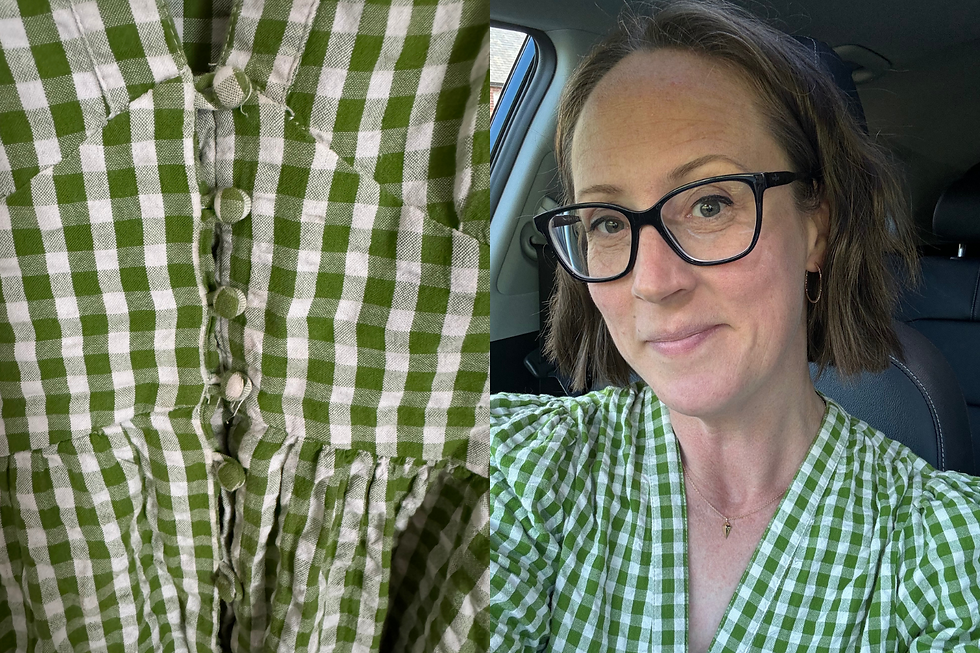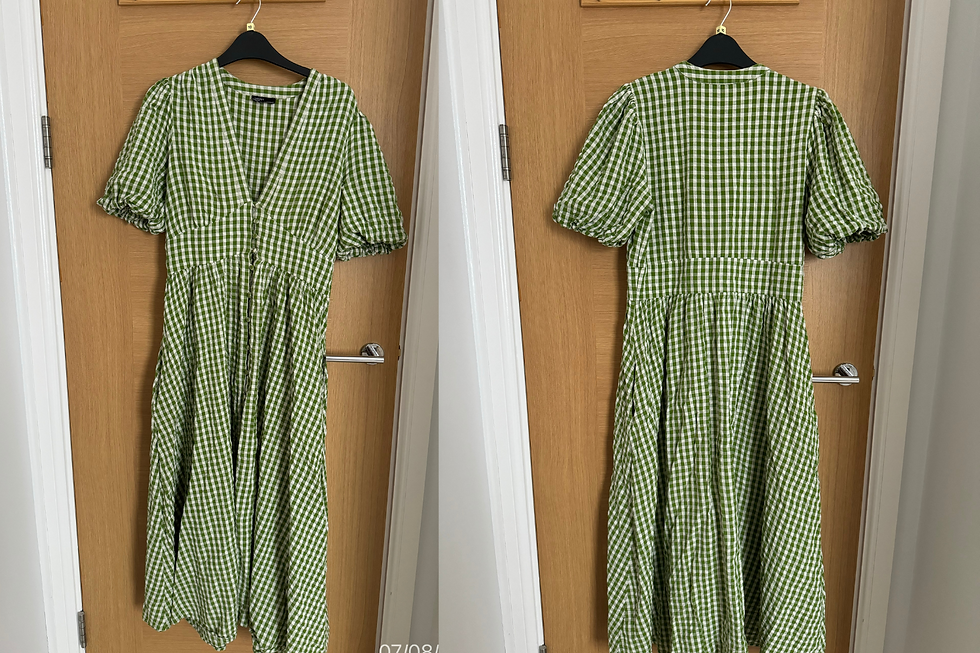This summer, I was invited to a party to celebrate a friend’s 50th birthday, and I always love the anticipation of a party and the excitement of planning my outfits.

In the past, I would have likely impulsively bought a new outfit for such an occasion, only to wear it once and then forget about it in my wardrobe. However, over the last seven years, I’ve shifted toward more sustainable fashion choices and have become more mindful of my purchases. While I still enjoy the convenience of shopping online, I now prefer exploring options like Vinted or eBay for pre-loved items instead of buying new clothing.
I have often borrowed from my sister’s wardrobe and benefited from quite a few of her clear-outs—a sort of ‘hand-me-up,’ since I’m the eldest! So, when planning my outfit for this party, I wondered: what if I could access a larger group of wardrobes and borrow what I wanted?
Last year, I read Eleanor Tucker’s book, "Thanks for Sharing," in which she shared her experience renting a dress. Inspired by her journey, I set off to investigate whether clothing rental might be an option for me
Why Choosing to Rent Clothing is a Smart Sustainable Option
The global fashion industry is responsible for 10% of all greenhouse gas emissions. The production of clothing requires significant amounts of water and energy, particularly during the dyeing and manufacturing processes. Additionally, there’s the carbon footprint associated with transporting garments, often around the globe from where they are made to where they are sold.
It’s not just the environmental impact; the human cost is high as well. Many garment workers continue to work for shockingly low wages in poor conditions.
In much of the global North, clothing has become so affordable that we buy far more than we actually need. An estimated 1.6 billion items of unused clothing are sitting in wardrobes across the UK (source: BBC). If we shared more of what we already have, we could significantly reduce our impact on the planet.
Just as sharing party kits helps us maximise the energy and resources that went into creating reusable tableware, clothing rental can help us lessen our environmental footprint in several ways. Renting clothes allows items to be used multiple times by different people, extending their lifespan and reducing the number of garments that are underused or simply discarded.
So, that’s all great, but how do I actually go about renting a dress?
Exploring the Options for Clothing Rental
Renting clothes isn’t a new concept. It’s quite common to hire formalwear like tuxedos and ball gowns. For instance, when I got married, we rented suits for the groomsmen.
However, renting rather than buying an item does require more forethought. I began my search four weeks before the party, as there isn’t yet the same availability of rental items as you find on retail sites.
Here are the main options for renting:
Renting from a Rental Company: The company owns the item and lends it to you. This could be a local business or one which can post out garments to you.
Renting Directly from a Brand or Retailer: In an effort to promote sustainable fashion, more brands and retailers are starting to offer rental services. For example, John Lewis now rents out designer womenswear.
Renting from Another Person: This involves borrowing a garment directly from another individual (peer-to-peer clothing rental), which can be organised through a local swap group or a dedicated rental platform.
Since I was looking for a specific dress design, my options were limited. On many of the websites and apps I explored, the user experience wasn’t as polished as what we see on established retail websites, which became evident as I tried to find something specific.
How to arrange a peer-to-peer dress rental
I found what I was looking for on the By Rotation app, a peer-to-peer lending platform with over 120,000 items available for rent.
To hire the dress I wanted, I submitted a rental request. Most items have a minimum hire period of four days, but generally, you can rent an item for as long as you need, which provides more flexibility if you’re going away or looking to maximize your rental by wearing it multiple times. Once a request has been submitted, a notification is sent to the garment owner, who can then approve or decline the request. The rental fee is paid through the app, much like placing an order on an e-commerce website. This process took about 24 hours.
If you live close enough to each other, you can arrange an in-person handover, saving on postage. Otherwise, the clothing is shared by post. In this case, the rental fee includes the cost of outbound postage, while I only had to pay for the return postage at the end of the hire period. The rental fee also includes insurance, just in case of any mishaps.
When booking my rental, I was a bit concerned about sizing. This is another area where rental platforms could provide more support to help renters ensure a successful experience. One option would be to arrange multiple rentals, but in this case, I already had another dress from the same brand, so I felt fairly confident it would fit.
It’s now all booked in. Let’s see what happens!
The Dress Arrives: The Next Step in the Rental Journey

As with all sharing—be it party kits, tents, or dresses—trust between the owner and the renter is essential. You must trust that the owner will send the item as promised, while the owner must trust that the renter will care for the item and return it on the agreed date.
I arranged for the dress to arrive a couple of days before the party to avoid any last-minute issues, and it actually arrived earlier than expected.
When the item arrives, By Rotation recommends taking photos to document its condition. There was a small thread pull on the skirt, which I repaired. I appreciate that this dress carries a history, reflecting the experiences of everyone who has worn it.
I ended up wearing the dress twice: first to dinner with my sister on Friday night and then to the party on Saturday. This was a bit risky, as I got a little dinner on it, but I managed to spot clean it before the party.
There weren’t clear instructions regarding cleaning expectations, so I washed it on Sunday before returning it on Monday. If an item is dry clean only, the cost of cleaning is typically included in the rental fee, and the owner arranges this after the item is returned. From what I’ve learned about clothing rental since, renters are generally not expected to wash garments before returning them.

Once again, I took time-stamped photos of the dress before packing it up for return. I used Royal Mail's Tracked service with doorstep collection, making it a breeze.
Conclusion
Would I try it again? Absolutely!
Overall, I was pleased with my first rental experience and appreciated the greater selection that comes from renting from people over a wider distance, compared to just borrowing from my sister or local friends.
The benefits of wearing an item without the upfront cost, as well as avoiding the need to store something I’ll only wear occasionally, are appealing.
It’s also a better value proposition. The owner has the opportunity to earn income from an asset that would otherwise sit unused in their wardrobe, while I, as the renter, benefit from affordability. The cost of hiring for four days was only 25% of the price of buying the item new. And the savings are probably even bigger for more expensive brands.
Renting allows us to experiment and take more risks. I chose a fabric I probably wouldn’t have purchased outright, but knowing I could return it gave me the freedom to try something new.
For this model to truly thrive, the process of finding and arranging a rental needs to be more streamlined. On some websites, filtering by size was a challenge. Many aspects of the rental journey can be learnt from successful e-commerce sites that have spent decades refining their purchasing processes. However, the post-booking experience must be more supportive, especially since this type of peer-to-peer rental will be new for many of us.

